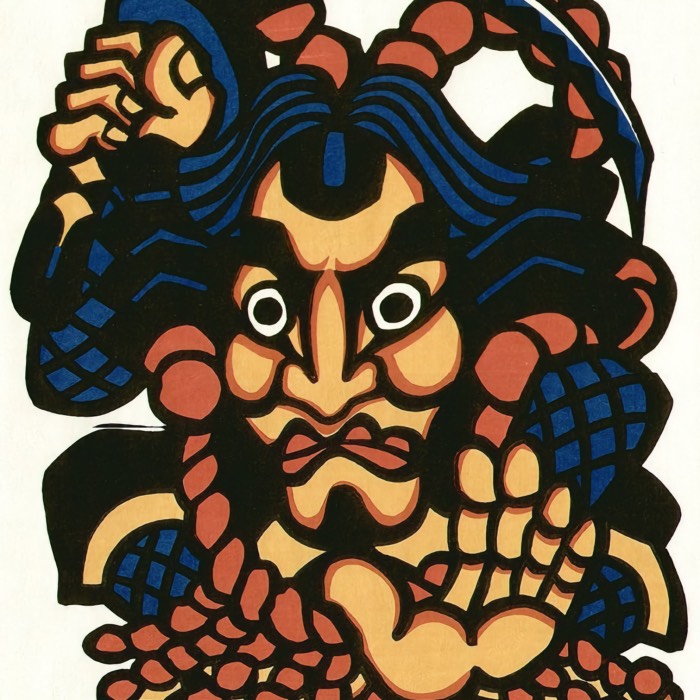Minagawa Taizo: A modern innovator in the Shin Hanga tradition
Minagawa Taizo (1917-2005) was a Japanese artist known for his work in textiles and woodblock printing. He was a master craftsman who blended traditional Japanese techniques with modern aesthetics, creating works that were both beautiful and innovative. Minagawa’s art reflects his deep connection to Japan’s cultural heritage and his willingness to experiment with new forms and ideas. This post explores Minagawa’s life and work, highlighting his contributions to the Shin Hanga movement and his enduring legacy in Japanese art.
 Daimonji Fire Display, Minagawa Taizo, 1964. Source: ukiyo-e.orgꜛ
Daimonji Fire Display, Minagawa Taizo, 1964. Source: ukiyo-e.orgꜛ
Biography
Minagawa Taizo (皆川 泰三), born in 1917 in Kyoto, Japan, was an influential artist and craftsman whose work spanned the mid-20th century, contributing significantly to the Shin Hanga movement’s later years. While not as widely known as some of his predecessors, Minagawa was a master of textile art, particularly in weaving, and he was also recognized for his contributions to woodblock printing, where he explored the intersection of traditional Japanese techniques and modern artistic sensibilities.
Minagawa was born into a family with a rich artistic heritage in Kyoto, a city known for its deep cultural traditions. From a young age, he was immersed in the arts, particularly in the craft of textile design, which would become his primary focus. He studied at the Kyoto City School of Fine Arts and Crafts, where he was trained in traditional Japanese crafts, including dyeing and weaving. This education provided Minagawa with a deep understanding of the techniques and aesthetics that would later define his work.
In addition to his work in textiles, Minagawa was deeply influenced by the Shin Hanga movement, which sought to revive traditional Japanese woodblock printing while incorporating modern elements. Although primarily known for his textile art, Minagawa applied the principles of Shin Hanga to his woodblock prints, blending the delicate craftsmanship of traditional Japanese art with the innovative spirit of the modern era.
Minagawa’s work was well-received in Japan and abroad, particularly in the post-war period when there was a renewed interest in Japanese art and craftsmanship. His prints and textiles were exhibited widely, and he became known for his ability to harmonize traditional Japanese aesthetics with contemporary design.
Minagawa Taizo passed away in 2005, leaving behind a legacy as a master craftsman and a bridge between the traditional and modern in Japanese art.
Artistic style and significance
Minagawa Taizo is best known for his work in textiles, but his contributions to woodblock printing also reflect his deep engagement with the principles of the Shin Hanga movement. His work is characterized by a meticulous attention to detail, a profound respect for traditional techniques, and a willingness to experiment with new forms and ideas.
Textiles and the art of weaving
Minagawa’s primary focus was on textile art, particularly in weaving and dyeing. He was renowned for his ability to create intricate patterns and textures that reflected the beauty of traditional Japanese design while also embracing modern aesthetics. His textiles often featured subtle gradations of color and delicate patterns that were inspired by nature, such as the changing seasons, the play of light and shadow, and the textures of natural materials.
Minagawa’s work in textiles was not only a continuation of Japan’s rich tradition in the craft but also an innovation in its application. He was known for his use of natural dyes and his dedication to preserving the integrity of the materials he worked with, ensuring that his creations were both beautiful and environmentally sustainable. His textiles were often used in traditional Japanese clothing, such as kimono, as well as in contemporary interior design, reflecting his versatility as an artist.
A modern interpretation of woodblock printing
While Minagawa’s textile work was his primary medium, he also made significant contributions to woodblock printing. His prints often reflected the same principles that guided his textile work—attention to detail, harmony with nature, and a blending of traditional and modern techniques.
Minagawa’s woodblock prints are noted for their simplicity and elegance. He often depicted scenes from nature, such as landscapes, flowers, and birds, with a focus on capturing the essence of the subject rather than its detailed representation. His use of color was subtle and restrained, creating prints that were serene and contemplative.
One of the defining features of Minagawa’s woodblock prints is his use of texture. Drawing from his experience in textile design, he incorporated textured surfaces into his prints, adding a tactile dimension that enhanced the visual experience. This fusion of textile techniques with woodblock printing was innovative and helped to push the boundaries of the Shin Hanga movement.
Legacy
Minagawa Taizo’s contribution to Japanese art is significant, particularly in the fields of textile design and woodblock printing. His ability to harmonize traditional Japanese techniques with modern aesthetics made his work relevant in a rapidly changing world. Minagawa’s prints and textiles continue to be celebrated for their craftsmanship, beauty, and the way they reflect the deep cultural traditions of Japan while also embracing the possibilities of modern design.
Minagawa’s legacy is not only in the works he created but also in the influence he had on future generations of artists and craftsmen. His dedication to preserving traditional techniques while also exploring new ideas ensured that the arts of weaving and woodblock printing remained vibrant and dynamic well into the 21st century.
Examples
Throughout his career, Minagawa Taizo produced several notable works, both in textiles and woodblock printing. Here are some of his most famous pieces:
 A Business in Gion, Minagawa Taizo. Source: ukiyo-e.orgꜛ
A Business in Gion, Minagawa Taizo. Source: ukiyo-e.orgꜛ
 Unread 1, Minagawa Taizo. Source: ukiyo-e.orgꜛ
Unread 1, Minagawa Taizo. Source: ukiyo-e.orgꜛ
 Unread 2, Minagawa Taizo. Source: ukiyo-e.orgꜛ
Unread 2, Minagawa Taizo. Source: ukiyo-e.orgꜛ
 Moon and Country House, Minagawa Taizo, late 20th c. Source: ukiyo-e.orgꜛ
Moon and Country House, Minagawa Taizo, late 20th c. Source: ukiyo-e.orgꜛ
 House of Potter in Kyoto, Minagawa Taizo, 1964. Source: ukiyo-e.orgꜛ
House of Potter in Kyoto, Minagawa Taizo, 1964. Source: ukiyo-e.orgꜛ
 Antique in a House, Minagawa Taizo, 1960s. Source: ukiyo-e.orgꜛ
Antique in a House, Minagawa Taizo, 1960s. Source: ukiyo-e.orgꜛ
 Interior of House, Minagawa Taizo, 1950s. Source: ukiyo-e.orgꜛ
Interior of House, Minagawa Taizo, 1950s. Source: ukiyo-e.orgꜛ
 Gion Festival, from Twelve Views of Kyoto, Minagawa Taizo, 1964. Source: ukiyo-e.orgꜛ
Gion Festival, from Twelve Views of Kyoto, Minagawa Taizo, 1964. Source: ukiyo-e.orgꜛ
 House in Kawaetsu, Minagawa Taizo. Source: ukiyo-e.orgꜛ
House in Kawaetsu, Minagawa Taizo. Source: ukiyo-e.orgꜛ
 Dog and Farm House in Winter, Minagawa Taizo, 1967. Source: ukiyo-e.orgꜛ
Dog and Farm House in Winter, Minagawa Taizo, 1967. Source: ukiyo-e.orgꜛ
 Moon over Hirosawa Pond, Minagawa Taizo, 1964. Source: ukiyo-e.orgꜛ
Moon over Hirosawa Pond, Minagawa Taizo, 1964. Source: ukiyo-e.orgꜛ
 Mt. Arashi, Minagawa Taizo, 1964. Source: ukiyo-e.orgꜛ
Mt. Arashi, Minagawa Taizo, 1964. Source: ukiyo-e.orgꜛ
 Jakkou-in, Minagawa Taizo, 1964. Source: ukiyo-e.orgꜛ
Jakkou-in, Minagawa Taizo, 1964. Source: ukiyo-e.orgꜛ
 Ryuanji no Sekitei, Minagawa Taizo, 1964. Source: ukiyo-e.orgꜛ
Ryuanji no Sekitei, Minagawa Taizo, 1964. Source: ukiyo-e.orgꜛ
 Garden of Ryuan Temple, Minagawa Taizo, 1960s. Source: ukiyo-e.orgꜛ
Garden of Ryuan Temple, Minagawa Taizo, 1960s. Source: ukiyo-e.orgꜛ
 Garden of Nijo Castle, Minagawa Taizo, 1950-1960s. Source: ukiyo-e.orgꜛ
Garden of Nijo Castle, Minagawa Taizo, 1950-1960s. Source: ukiyo-e.orgꜛ
 House in Shirakawa, Minagawa Taizo, 1965. Source: ukiyo-e.orgꜛ
House in Shirakawa, Minagawa Taizo, 1965. Source: ukiyo-e.orgꜛ
 House in Shirakawa, Minagawa Taizo, 1965. Source: ukiyo-e.orgꜛ
House in Shirakawa, Minagawa Taizo, 1965. Source: ukiyo-e.orgꜛ
 Stone Garden of Daisenin, Minagawa Taizo, 1964. Source: ukiyo-e.orgꜛ
Stone Garden of Daisenin, Minagawa Taizo, 1964. Source: ukiyo-e.orgꜛ
 Daizan, Minagawa Taizo. Source: ukiyo-e.orgꜛ
Daizan, Minagawa Taizo. Source: ukiyo-e.orgꜛ
 Yasaka Pagoda, from Twelve Views of Kyoto, Minagawa Taizo, 1964. Source: ukiyo-e.orgꜛ
Yasaka Pagoda, from Twelve Views of Kyoto, Minagawa Taizo, 1964. Source: ukiyo-e.orgꜛ
 Graceful Soshu Garden,. Source: ukiyo-e.orgꜛ
Graceful Soshu Garden,. Source: ukiyo-e.orgꜛ
 Textile design, Minagawa Taizo. Source: ukiyo-e.orgꜛ
Textile design, Minagawa Taizo. Source: ukiyo-e.orgꜛ
Conclusion
Minagawa Taizo is remembered as a significant figure in the later years of the Shin Hanga movement, particularly for his contributions to textile design and woodblock printing. His work, characterized by its elegance, attention to detail, and harmonious blend of traditional and modern techniques, continues to be celebrated for its beauty and craftsmanship. Minagawa’s legacy as a master craftsman and innovative artist ensures that his work remains highly valued by collectors and continues to inspire future generations of artists.
References and further reading
- Chris Uhlenbeck, Jim Dwinger, Philo Ouweleen, Shin Hanga - Die »Neuen Drucke« Japans 1900-1950, 2022, Hatje Cantz, ISBN: 9783775752190
- viewingjapaneseprints.netꜛ
- Minagawa Taizo on ukiyo-e.orgꜛ










comments